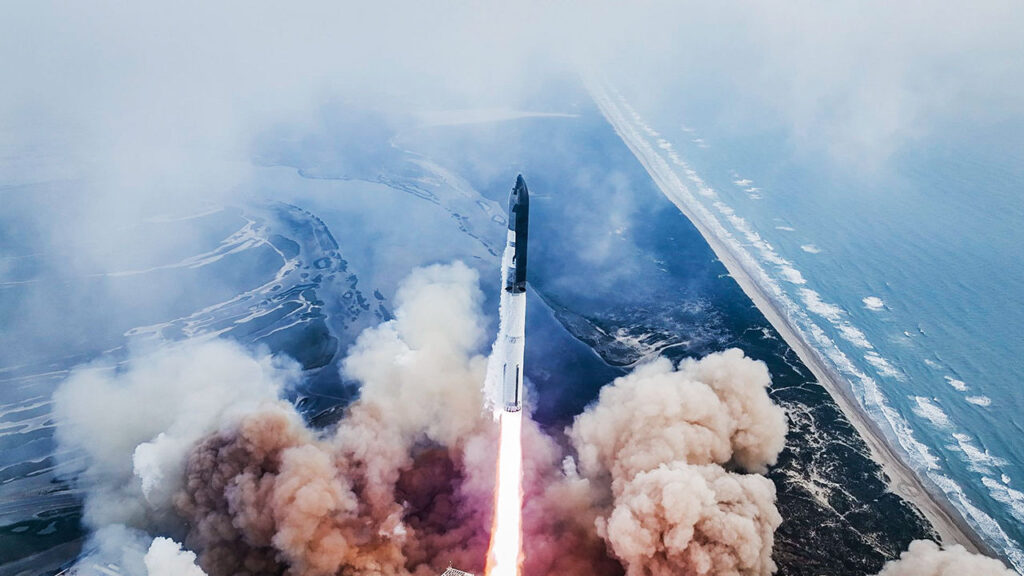SpaceX launches starship to assess the reusable heat shield’s performance, it is launched into space as the vehicle attempts a safe reentry into the atmosphere.
The primary purpose of a potential fourth launch of SpaceX’s enormous Starship rocket on June 5 is to assess the reusable heat shield of the second stage as the vehicle attempts to reenter the atmosphere safely.
On his social media platform X, the chief executive officer, Elon Musk, stated, “There are numerous difficult problems to resolve with this vehicle, but the most significant is the unprecedented creation of a reusable orbital return heat shield.”
His post mirrors remarks he made earlier this month in which he stated that “getting through maximum reentry heating” was the primary objective of the subsequent Starship test.
Consequently, the novel heat barrier for the second stage, which consists of approximately 18,000 hexagonal ceramic tiles, will be evaluated. The purpose of these modules is to shield the second stage, also known as Starship, from the exceedingly high temperatures encountered during its reentry into the Earth’s atmosphere. Musk suggested that the overall vulnerability of the system is one of the most significant problems: “We are not resilient to the loss of a single tile in the majority of locations.” This means that even a solitary defective or damaged tile has the potential to result in severe consequences.
Musk noted in his post that Reentry survival is only one problem component. Additionally, the organization will be required to develop an “entirely new supply chain” and produce the high-performance heat shield tiles in extremely high quantities.
Overcoming this formidable challenge would bring them one step closer to achieving complete reusability, considered the pinnacle of launch vehicle utilization. SpaceX made significant progress in reusability with its mainstay Falcon 9 rocket, which has completed 56 flights this year. However, while the company manages to recover the booster, the second stage is depleted in its intended orbit. SpaceX aspires to significantly reduce expenses to a fraction of their current level by reprocessing both stages of the rocket while propelling several orders of magnitude more mass into orbit with a single launch. (Per kilogram, Transporter rideshare missions from SpaceX cost $6,000.)
The organization will showcase its capability to return Starship to Earth through a controlled reentry and a gentle splashdown in the Indian Ocean, assuming all operations proceed as scheduled. Additionally, SpaceX intends to return the Super Heavy booster via ocean splashdown. Furthermore, it will advance the process of operationalizing the most sizable and potent launch system ever constructed, capable of propelling crew and cargo beyond Earth’s orbit.
Commencing in April of last year, this subsequent Starship launch will constitute the fourth in a sequence of orbital flight trials. Before proceeding, SpaceX must obtain a commercial launch certification from the U.S. Federal Aviation Administration, the regulatory agency for commercial launch operations. Because it also supervises investigations into rocket launches that fail for whatever reason, the FAA has maintained a close working relationship with SpaceX during the Starship test campaign.
Furthermore, previous Starship launches have undoubtedly encountered difficulties: the initial two culminated in fiery mid-air detonations, and the third concluded with the probable disintegration of both Super Heavy and Starship before their impact with the ocean. However, each test was ultimately fruitful for SpaceX, which employs an iterative methodology for hardware development, as it provided engineers with data about the rocket during a real-life flight scenario. Indeed, each subsequent mission has covered a greater distance than its predecessor. As Starship ascended during its third voyage, the engines completed full-duration burns, and the craft ultimately entered orbit.
SpaceX’s ultimate objective is to land the Starship second stage and Super Heavy booster at its launch facility in southeast Texas, where they can be expeditiously reconditioned and returned to the pad.
